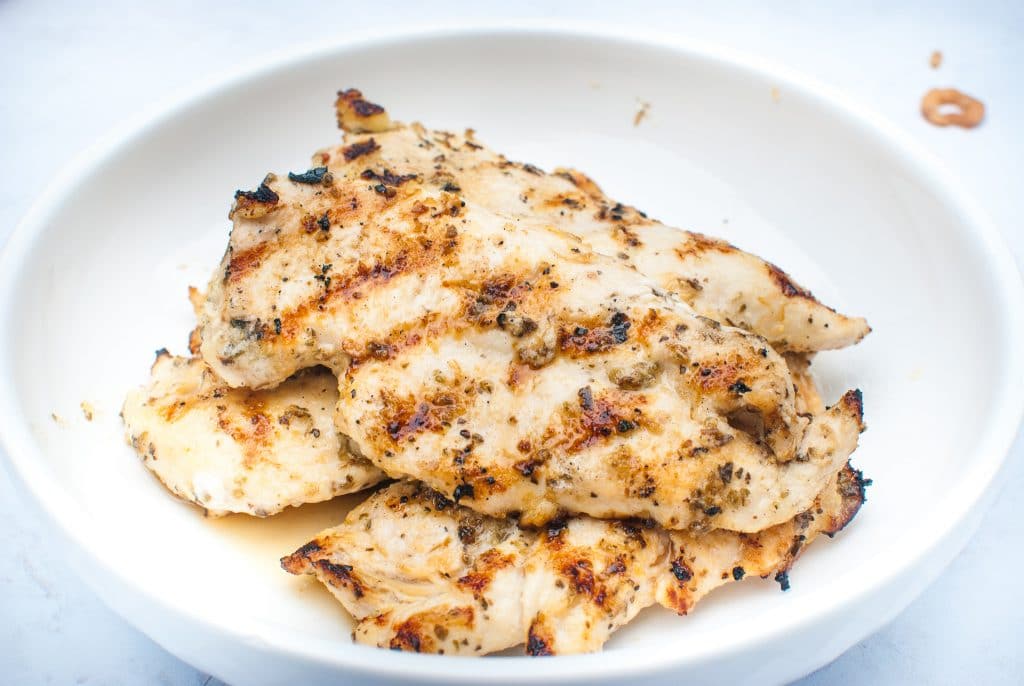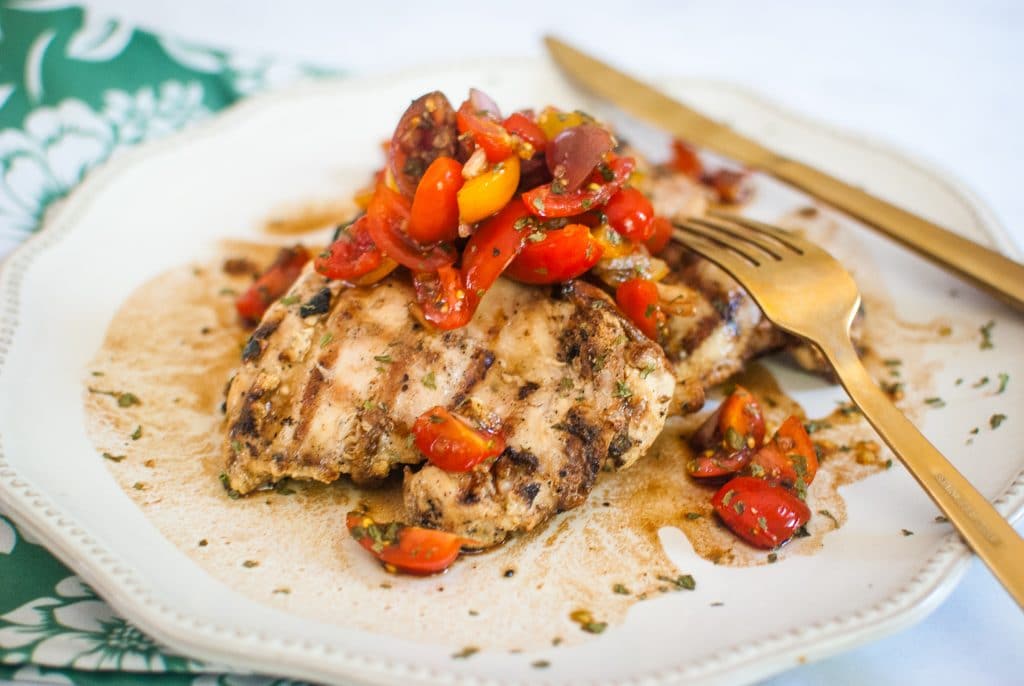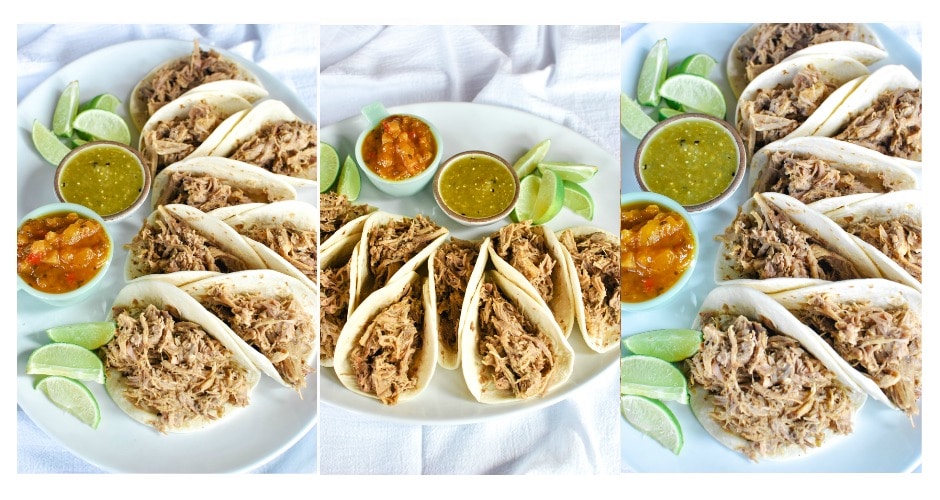How to Cut a Whole Beef Tenderloin into Filet Steaks
How to Cut a Whole Beef Tenderloin into Filet Steaks is THE way to take an expensive cut of meat and trim it to your liking. You’ll cut out 3-4 various meals from this one whole tenderloin, and the tenderloin steaks will become your favorite in no time!
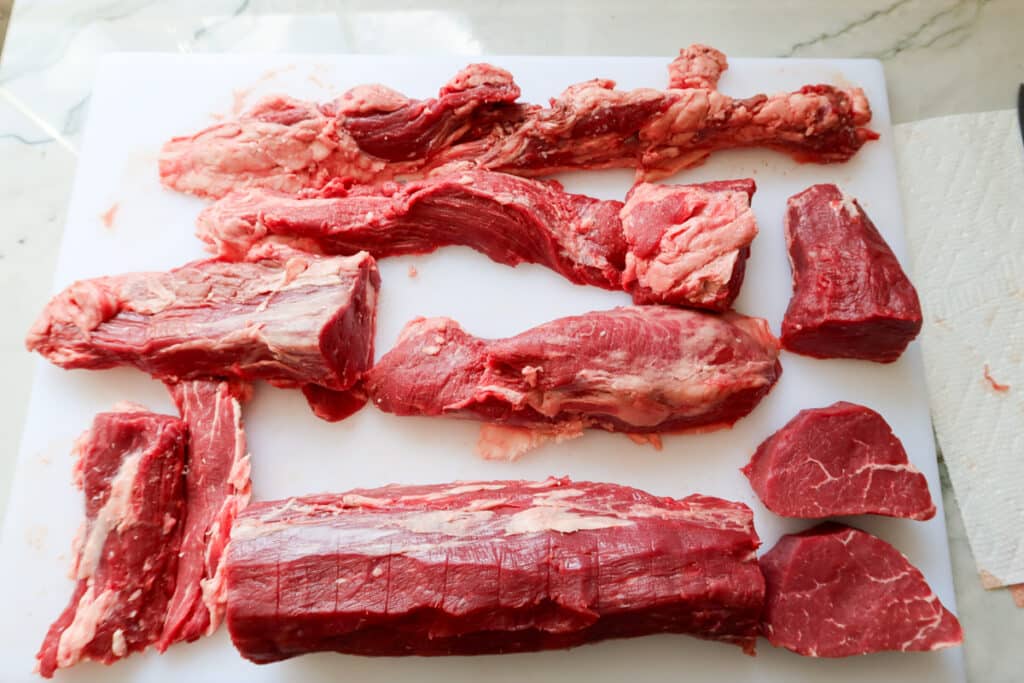
There’s something truly special about a whole beef tenderloin that sets it apart for those moments that command a culinary flourish.
Revered as one of the most expensive cuts of beef, this majestic piece of meat boasts a melt-in-your-mouth tenderness that’s second to none.
Preparing whole tenderloin at home, whether you’re eyeing succulent tenderloin roasts or the highly coveted filet mignon steaks, underscores a labor of love and a testament to your dedication to good meat. Whole tenderloin is not just a cut; it’s an experience, serving as the centerpiece for special occasions, promising both satisfaction and pride in every slice.
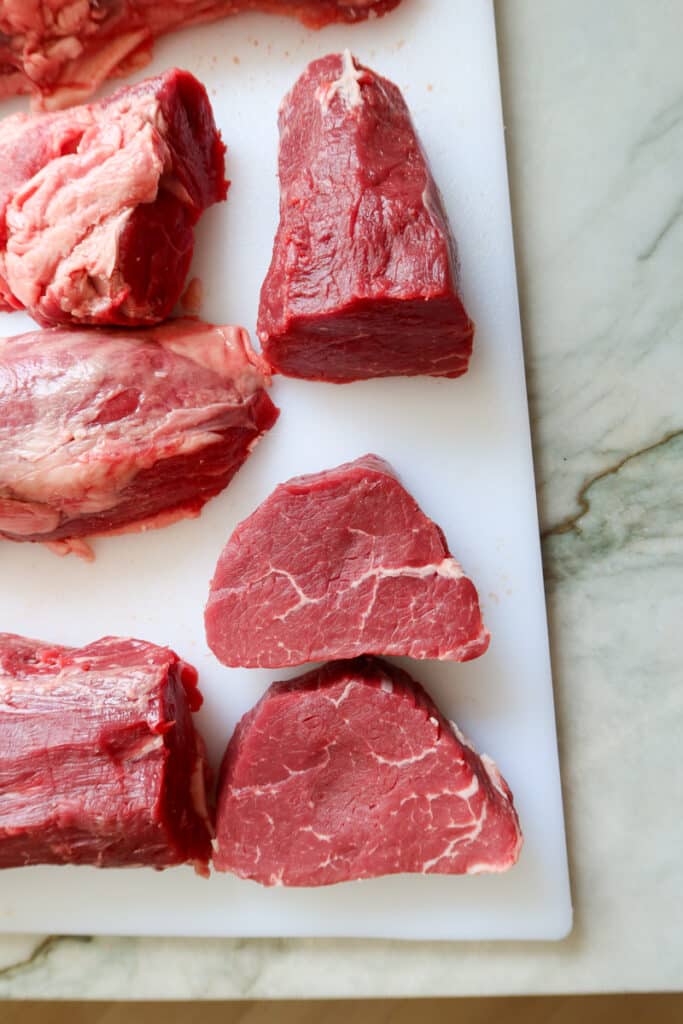
Key Takeaways:
- Whole beef tenderloin holds a place of honor among cuts of meat, celebrated for its exquisite tenderness.
- Preparing whole tenderloin at home brings a sense of occasion, perfect for making tenderloin roasts and filet mignon steaks.
- Its versatility and premium quality make it the ideal choice for special occasions, delivering unmatched flavor and texture. And while it is expensive, this post shares how this one whole tenderloin breaks down into 3-4 meals for several people.
Tools of the Trade
Before we dive into slicing that luxurious whole beef tenderloin into succulent filet mignon steaks, let’s make sure we’ve got all our ducks in a row – or should I say, all our tools on the counter?
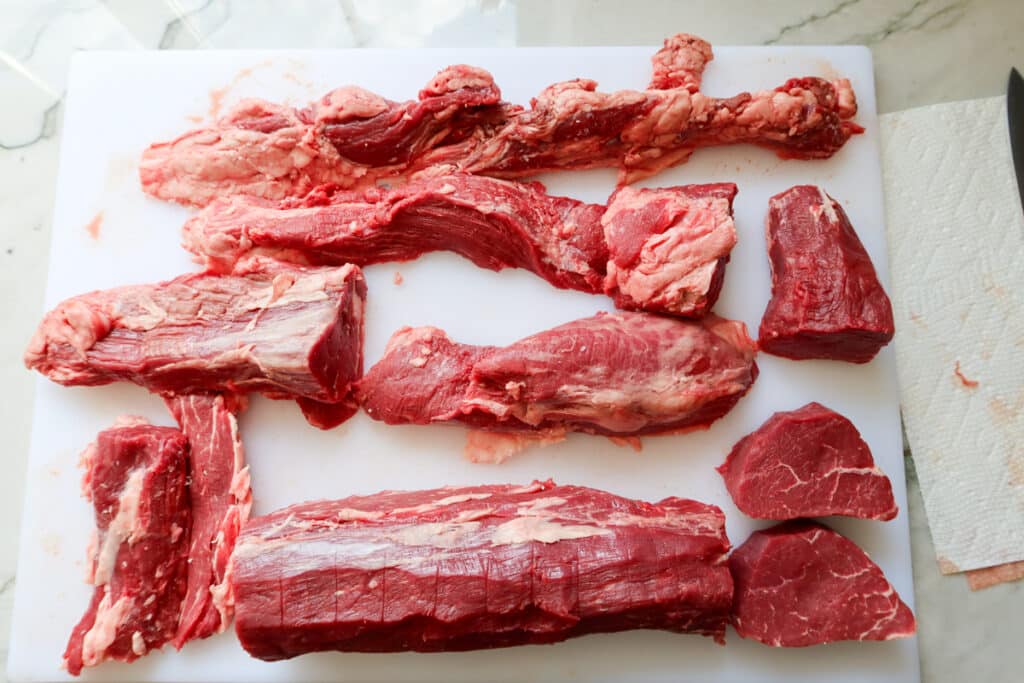
Here’s what you’ll need to make this endeavor a success:
- A sharp knife: This isn’t just any knife; it’s the Excalibur of your kitchen, the very best friend of any aspiring steak master. Ensuring it’s razor-sharp will make slicing through the tenderloin like cutting through butter.
- Paper towels: Probably not what you were expecting in a list of cutting tools, right? But trust me, keeping the tenderloin dry and ready for a clean cut, as well as maintaining a tidy work area, is key to precision.
- Plastic Cutting Board: This is something I picked up at Sam’s Club for $9 in their catering section.
Preparing the Work Surface
First things first, let’s talk about setting up our work surface for slicing that whole beef tenderloin.
You know, this step might seem like a small task, but trust me, it’s a cornerstone for ensuring everything goes smoothly.
Now, grab a large cutting board – yes, it needs to be big! Because when you’re dealing with an entire beef tenderloin, space is not just a luxury; it’s a necessity. This large piece requires room to maneuver, especially when you’re eyeing to transform it into those mouth-watering filet mignon steaks.
But here’s a little trick I’ve learned along the way: keep paper towels within arm’s reach. I like to peel off a bunch and just stack them up beside my workstation.
Why, you ask? Well, patting the beef dry with paper towels isn’t just about cleanliness; it’s about getting that perfect sear on the steaks later.

So, remember, a clean cutting board and these handy helpers are your best friends in this culinary adventure.
Pro Tip: Don’t let your cutting board slide around on you! Add a damp paper towel underneath it and it will stay put.
Initial Steps
First, let’s dive right into the world of whole beef tenderloin with enthusiasm, shall we?

Here’s how I kick things off – step-by-step and with no room for doubt.
Believe me, it’s simpler than it sounds, and with a little practice, you’ll be slicing like a pro in no time.
- Remove the whole beef tenderloin from its packaging – This might seem obvious, but it’s the essential first step. You can’t work on it while it’s all wrapped up, after all. I do this in the sink because it’s messy and gross.
- Pat the tenderloin dry with paper towels – Don’t just give it a quick wipe; you want to make sure it’s thoroughly dry to handle it better during the slicing phase. Excess moisture is a no-go.
- Place your tenderloin on your big cutting board – And smooth it out so it’s straight.
Separating the Tenderloin
Looking at the large tenderloin sprawled out on my clean cutting board, I know the first step to culinary mastery lies before me.
It’s about identifying the main portion of the tenderloin, separate from the smaller pieces that could distract from the perfection I’m aiming for.
There are two main sections you’ll be removing:
The Chain – perfect for beef stew, beef tips, and other ways where braising is the main cooking method.

The Heel – this looks and feels like a mini beef tenderloin. It’s where most restaurants get the “beef medallions” from. Some butchers don’t separate this and instead use butcher twine to wrap everything close to the tenderloin.
I notice the chain, that smaller, more fatty piece running along the side, and the side muscle that doesn’t exactly scream ‘filet mignon.’
With a sharp knife in hand – a trusty extension of my will – I gently, but confidently, free the prime part of the tenderloin from these extras. I start by using a free-hand pulling motion. It usually just peels away with ease from the tenderloin. This chain is great for beef stew!
Move up to the Heel, pull that off with a free-handed motion, and then move to using your knife.
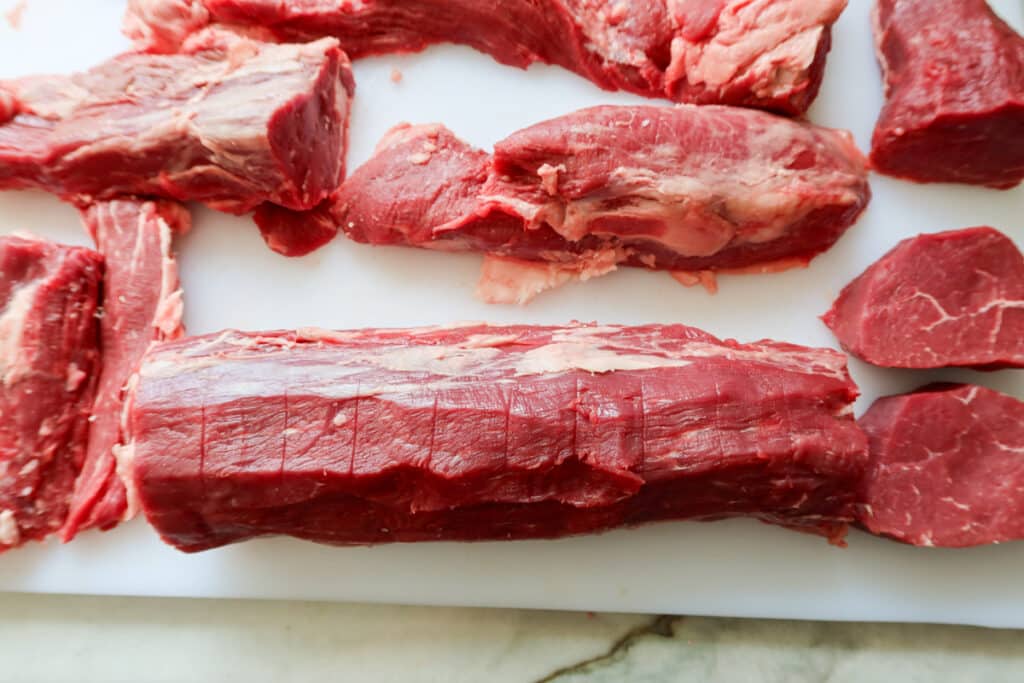
Why do I remove the heel and not tie it to the tenderloin? I like to remove every last bit of silver skin. And there is a lot of silver skin under The Heel.
Each various “piece” gets cut up and placed in freeze-safe bags to use later. I like to label them well, so I know which part of the tenderloin I’m getting out of the freezer when I need it.

Trimming Excess Fat and Silver Skin
First off, gather up your courage because this step, my friends, is where you make it or break it.
You can see me do this in real-time over on my YouTube Video!
Grab that sharp knife—yes, it’s got to be sharp because you and I, we’re about to tackle that silver skin and excess fat like pros.
Picture this: your whole beef tenderloin laid out, looking majestic. But hidden beneath its surface is some tough connective tissue, and that’s the silver skin and fat we’re after. It’s that part that when you’ve eaten steak, and chewed on one piece for forever, politely trying to spit it out… That’s silver skin. It’s so nasty, and we do not need it!
So, here’s the play: you gently slide the tip of your knife under that shiny layer, lifting up just enough to get a grip. Then, with a mix of grace and determination, you slide the knife away from you, keeping it angled slightly upwards. You’re not hacking away; you’re guiding it, removing that silver skin and fat, leaving nothing but tender, succulent meat ready for the most perfect steak experience.
And trust me, this bit of effort? It’s what sets apart okay steaks from ‘Oh WOW’ filet mignon steaks, especially for those special occasions. It’s the best way to absolutely wow your guests!
Slicing Steaks
Let’s dive into how you can slice that whole beef tenderloin into perfect individual steaks, shall we?
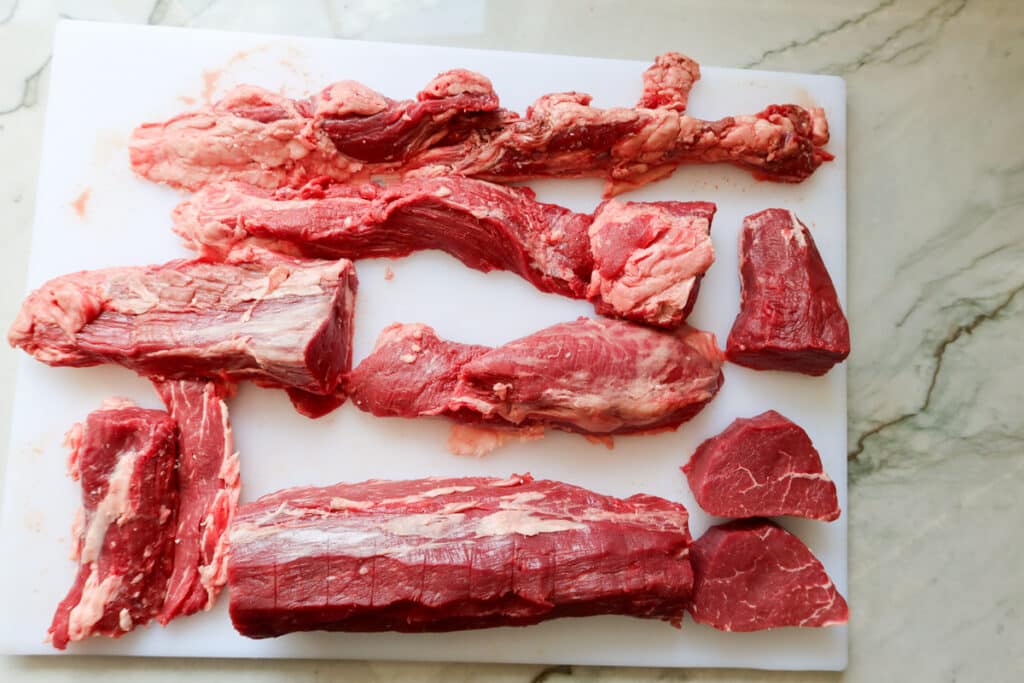
Grab your sharp knife and let’s do this.
First step, ensure your tenderloin is dry with paper towels.
Now, look for the tapered end and the thick end – they’ll guide your cuts for even cooking.
Freehand cut the tenderloin across its width, eyeing for uniform thickness in each steak.
Remember, the narrow end may produce smaller steaks, which is perfectly fine. If you’re not so confident in your ‘even-thickness’ skills just yet, little practice will turn you into a pro.
The key is to slice confidently, aiming for about 1 ½ to 2 inches thickness for that perfect filet mignon.

And there you have it, beautifully cut steaks ready for the pan, grill, or your next dinner party masterpiece. Slicing your own beef tenderloin not only saves you a penny but also grants you chef-level bragging rights at your next gathering.
Now, I like to cut off the narrow end of the tenderloin and the tapered side of the tenderloin, leaving one larger whole piece of beef tenderloin. Referred to as “Chateaubriand Cut.”
It’s what I use in my Whole Roasted Beef Tenderloin recipe!
Cooking Tips and Suggestions
Once you’ve expertly sliced your filet mignon steaks from that luscious whole beef tenderloin, you’ll want to cook them just right.
Here’s the scoop: Preheat your pan until it’s nice and hot, drizzle a bit of olive oil in, and listen for that sizzle as you lay the steaks down.
Aim for an internal temperature of 135°F for medium-rare, letting the magic happen as those muscle fibers tenderize into buttery softness.
Rest your steaks under a cozy tent of foil before serving to let all those delicious juices redistribute.
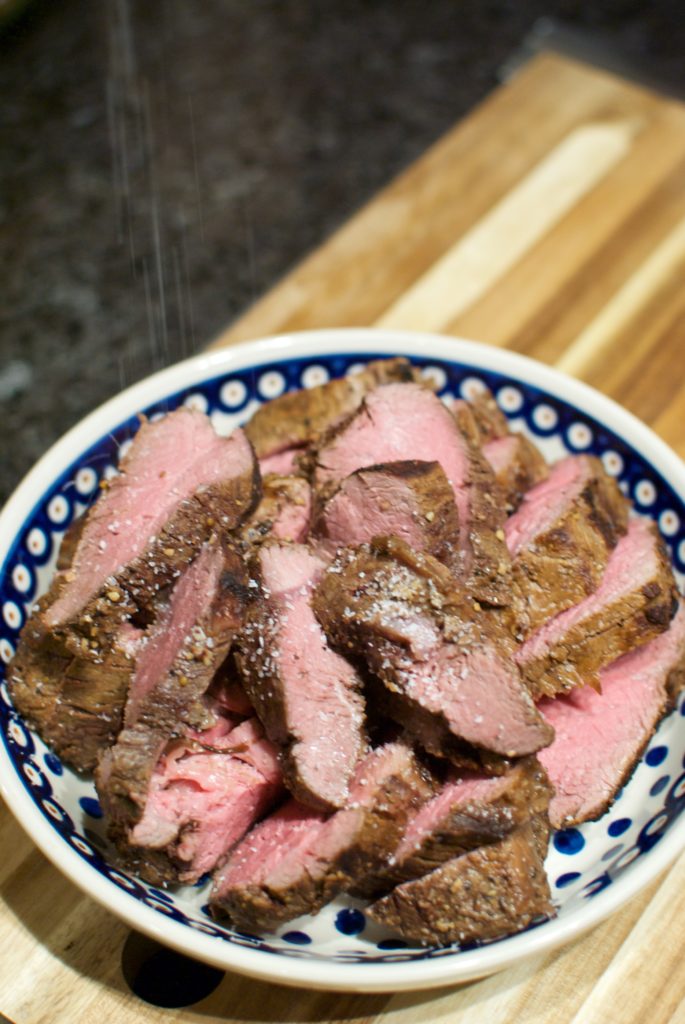
And for the grand finale? Pair them with a side of creamy mashed potatoes and a giant salad.
There you have it, a dinner that screams special occasion but whispers, “It was so easy.”
The Final Slice: Enjoying Your Mastery
After mastering the step-by-step process of transforming a whole beef tenderloin into exquisite filet mignon steaks, you’ve truly honed a skill worth celebrating.
It’s not just about the slicing; it’s about bringing a part of yourself to the table, something you crafted with your own hands.
Imagine the look of astonishment and delight on your friends and family’s faces at your next dinner party when you reveal that the tender, succulent steaks they’re enjoying were prepared by you, from the initial trim to the final slice.
There’s a profound joy in serving good meat, that you’ve transformed with little work and a lot of love, elevating a special occasion into something unforgettable.
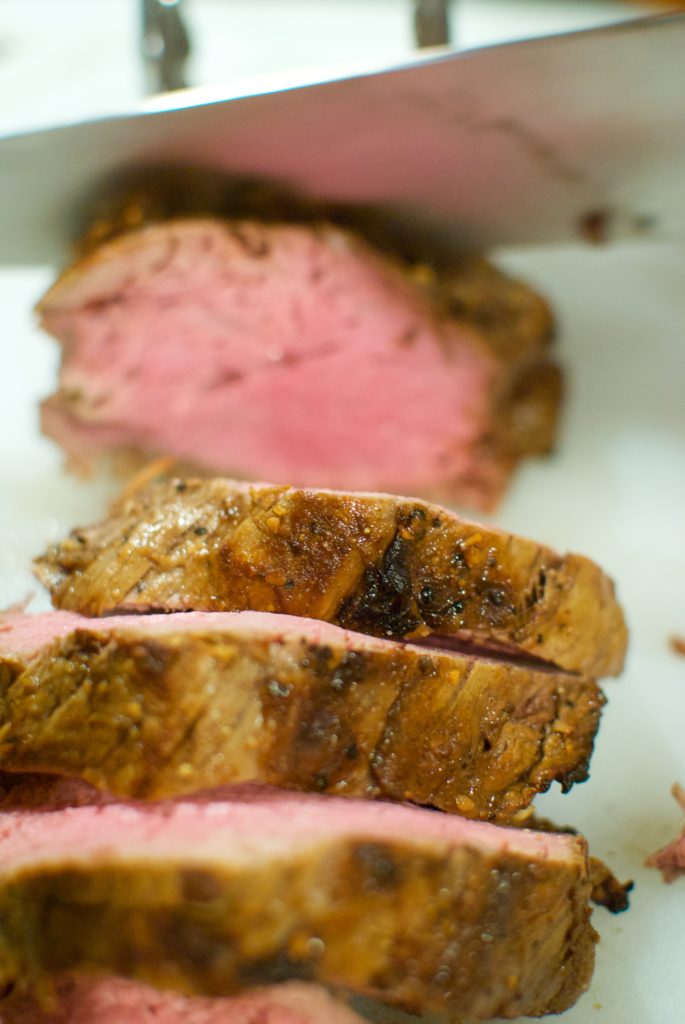
So, take a moment, pat yourself on the back, and savor the delicious fruits of your mastery over one of the most expensive cuts of beef.
Your kitchen isn’t just a place where meals are made; it’s where culinary magic happens, thanks to you.

